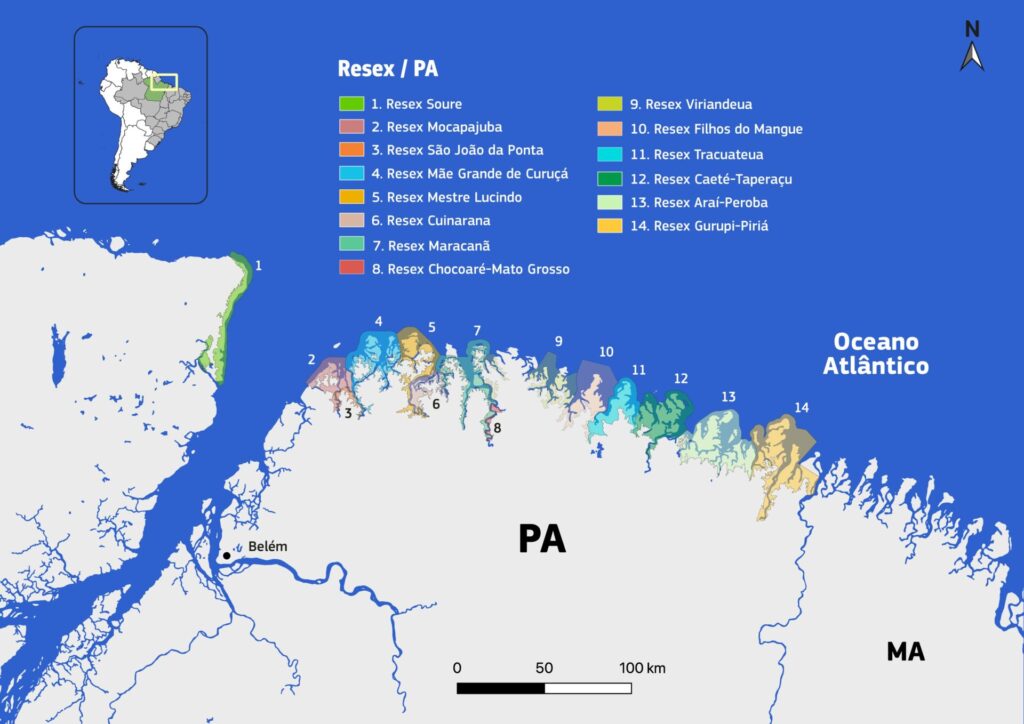In Brazil’s Pará state, fishing is life. Ninety percent of Brazil’s fishers are small-scale fishers, with most living in the north and fishing along the mangroves of the Amazon coast.
This makes healthy mangroves, which anchor ecosystems and sustain fish populations and other marine life, essential to local livelihoods and food security, as well as the fight against climate change.
So, when Brazilian President Luiz Inácio Lula da Silva recently signed a declaration establishing 2 new Resex in Pará—about 200 km northeast of Belem where the UN’s international climate conference (COP30) will be held in 2025—it was both a lifeline to coastal communities in the region and the culmination of sixteen-years of fishing communities pushing the national, state, and local government to act.
The Resex, or extractive reserve designation, is a sustainable use designation by the national system of conservation law allowing for use by fishers, oyster gleaners and other local harvesters, while protecting vital ecosystems from deforestation and industrial development.
View this post on Instagram
Video translation
Marina Silva, Brazilian Minister of Environment and Climate Change: First of all, thank you, Mr. President, for the priority you have given to the protection, restoration and sustainable use of our forests. In partnership with the State Government of Pará, efforts have been made to create two very important conservation units, the Filhos do Mangue Extractive Reserve and the Viriandeua Extractive Reserve.
Sonia Guajajara, Brazilian Minister of Indigenous People: It’s about environmental rights and guaranteeing human rights [00:00:30] for the inhabitants.
Marina Silva: What you’re saying is that we want to create more and more jobs, income and improve people’s lives through the sustainable use of forests.
Brazilian President Luiz Inácio Lula da Silva: As Brazil is hosting COP 30 and has a serious commitment to environmental preservation and decarbonization, we must start by preserving our forests and demarcating our indigenous lands and quilombolas. Either we do it, or we lose. We will win the cause of recovering the dignity of all the people in this country. Thank you all for your support.
[applause]
“We are going to hold COP30 here in Brazil, and we have a very serious commitment to the issue of environmental preservation, starting with the preservation of our forests, the demarcation of our indigenous lands,” said President Lula at the signing ceremony.
President Lula’s decree, which he signed on March 21, International Day of Forests, established the Viriandeua and Filhos do Manque resex, spanning over 75,000 hectares across the four municipalities of São João de Pirabas, Salinópolis, Quatipuru and Primavera in the Northeast of Pará state. The resex designation is critical as mangroves and the ecosystem they sustain are jeopardized by development, which has contributed to mangrove loss. A 2018 study by ICMBio (Chico Mendes Institute under the ministry of environment of Brazil), revealed that the country lost nearly 20 percent of its mangroves between 2000 and 2016.

The push for the resex designation was initiated by local communities in 2007. Rare subsequently joined the effort, after the reelection of Lula in 2022, acting as a liaison between local communities and the state and national governments, while also promoting sustainable fishing practices among local fishers.
“We did not start the process, but we did accelerate it,” said Monique Barreto Galvao, Vice President of Rare Brazil. “This achievement is the result of the collective effort of local leaders and extractive communities, and Rare is proud to have played a role.”
Rare’s Brazil team has spent years behind the scenes helping foster conversation and collaboration between local communities and national decisionmakers. At COP23 in Bonn, Germany in 2017, Rare joined Brazilian government officials in announcing an initiative to protect over 625,000 hectares of mangrove forests along Brazil’s northern coast.
Brazil’s Amazon coast is home to a massive mangrove forest, stretching nearly 14,000 sq km across Amapá, Pará, and Maranhão states. Mangrove forests are essential to local economies and food security, and are one of nature’s best tools for fighting climate change. They are a carbon sponge, absorbing CO2 that fuels climate change, while providing local communities a buffer from the impacts of extreme weather.
Pará state’s biologically diverse coastal zone provides food security and financial livelihood to over 80,000 people across more than 500 communities. The region also holds profound cultural importance for Indigenous Peoples and traditional groups who retain cultural practices, values, and ecological knowledge intrinsically connected to the mangroves. Protecting and investing in this region of the Amazon presents a unique opportunity to support biodiversity conservation, food security, and climate change mitigation.
Watch: How does climate change affect coastal communities along the Amazon coast?
Mangroves store up to 5 times more carbon than other tropical forests, gaining global relevance in this current context of climate crisis. The Climate Forever Project, carried out in a participatory manner with the 12 associations of the Marine Extractive Reserves of Pará, promotes the assessment of the perception and vulnerability of coastal communities in the face of climate change.